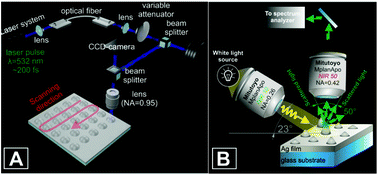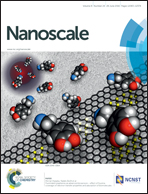Laser printing of resonant plasmonic nanovoids†
Abstract
Hollow reduced-symmetry resonant plasmonic nanostructures possess pronounced tunable optical resonances in the UV-vis-IR range, being a promising platform for advanced nanophotonic devices. However, the present fabrication approaches require several consecutive technological steps to produce such nanostructures, making their large-scale fabrication rather time-consuming and expensive. Here, we report on direct single-step fabrication of large-scale arrays of hollow parabolic- and cone-shaped nanovoids in silver and gold thin films, using single-pulse femtosecond nanoablation at high repetition rates. The lateral and vertical size of such nanovoids was found to be laser energy-tunable. Resonant light scattering from individual nanovoids was observed in the visible spectral range, using dark-field confocal microspectroscopy, with the size-dependent resonant peak positions. These colored geometric resonances in far-field scattering were related to excitation and interference of transverse surface plasmon modes in nanovoid shells. Plasmon-mediated electromagnetic field enhancement near the nanovoids was evaluated via finite-difference time-domain calculations for their model shapes simulated by three-dimensional molecular dynamics, and experimentally verified by means of photoluminescence microscopy and Raman spectroscopy.



 Please wait while we load your content...
Please wait while we load your content...